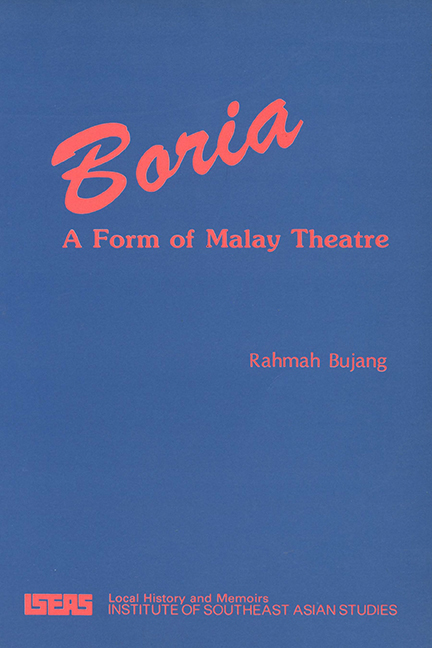6 - Boria and its Penang Audience
Published online by Cambridge University Press: 21 October 2015
Summary
Introduction
This chapter examines the symbolic action of boria in relation to the social action of the community which is its milieu. That is, I will try to relate the meaning of the performance to the ideals and behaviour of the society in which it is performed. In South- east Asia there is a complex and closely integrated relationship between symbolic action and social action; western mainstream drama largely lacks this — with its stress on the relationship between dramatic action and the audience.
The urban kampung Malays in certain areas of Penang have been involved in boria to such a degree as audience and performers and actors that virtually all the community members have at one time or another been participants. This being so, the question of relating to an audience, and which part of a community to the total community to establish relationships (between drama and society) does not arise; the audience, actors and performers are the community. In this situation symbolic action can be related directly to social action. The relationship exists; the problem lies in exposing the ways in which it is manifested. This can be established by examining involvement with and reaction to the symbolic action both inside and outside the theatre.
Boria Participation
In terms of the experience of the audience with boria, the Sungai Pinang troupes regularly interact with the Datuk Keramat, Air Itam (town) 1 and Jelutung Malays both during the show, when their communication takes the form of role player and active recipient, and in daily life as socially interacting categories of people. It was in these areas of deep involvement with the boria that the research was most intensive. In all, there was a random sample of 340 people from the Datuk Keramat area, 174 from Jelutung and 137 from Air Itam town with a total audience sample of 651 people. A special survey of actors and performers of troupes in those areas was taken and 79 of them formed the sample for the theatre.
- Type
- Chapter
- Information
- BoriaA Form of Malay Theatre, pp. 82 - 110Publisher: ISEAS–Yusof Ishak InstitutePrint publication year: 1987



